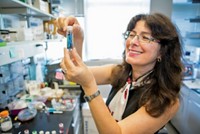Advertisement
Grab your lab coat. Let's get started
Welcome!
Welcome!
Create an account below to get 6 C&EN articles per month, receive newsletters and more - all free.
It seems this is your first time logging in online. Please enter the following information to continue.
As an ACS member you automatically get access to this site. All we need is few more details to create your reading experience.
Not you? Sign in with a different account.
Not you? Sign in with a different account.
ERROR 1
ERROR 1
ERROR 2
ERROR 2
ERROR 2
ERROR 2
ERROR 2
Password and Confirm password must match.
If you have an ACS member number, please enter it here so we can link this account to your membership. (optional)
ERROR 2
ACS values your privacy. By submitting your information, you are gaining access to C&EN and subscribing to our weekly newsletter. We use the information you provide to make your reading experience better, and we will never sell your data to third party members.
Business
Harvard Licenses Nanotech Patents
Nano-Terra gets Whitesides nanofabrication portfolio
by Ann M. Thayer
June 11, 2007
| A version of this story appeared in
Volume 85, Issue 24

HARVARD UNIVERSITY has granted licenses to the start-up company Nano-Terra for more than 50 issued and pending patents covering work from the laboratory of chemistry professor George M. Whitesides. The intellectual property (IP) covers microfluidics and nanofabrication methods for making advanced materials and devices.
According to the university, Nano-Terra gets exclusive commercialization rights to the technologies in all areas outside the biomedical field, where licenses already have been granted. In return, Harvard will receive an equity stake in Nano-Terra and royalties on any products developed from the licensed technologies.
Harvard believes it's making a safe bet on what is among the largest licensing deals it has ever inked. "George Whitesides has successfully commercialized IP developed in his Harvard laboratory for bioscience applications, and we expect he and the Nano-Terra team will fully capitalize on this groundbreaking technology," says Isaac T. Kohlberg, Harvard's chief technology development officer.
Whitesides helped create the biotech companies Genzyme, Geltex, and Theravance, which have a combined market value of nearly $20 billion. He's also behind the privately held drug optimization firm Surface Logix and the medical device company WMR Biomedical.
Privately held Nano-Terra was created in early 2005 by Whitesides and business collaborator Carmichael Roberts. The company's business plan is to leverage its IP and expertise through product development deals with major companies and the U.S. government.
Nano-Terra already has signed agreements with Merck KGaA, 3M, a major Asian electronics manufacturer, and the Department of Defense. It expects these deals to result in products within 18 to 36 months.
It's hard not to draw analogies to the experiences of Nanosys, which started up in 2001 with a similar approach to commercializing nanotechnology developments. Its founders include Harvard chemistry professors Charles M. Lieber and Hongkun Park, who work with inorganic nanostructures.
Nanosys has about 500 patents and patent applications; many were licensed from Harvard, Columbia University, Hebrew University, MIT, and the University of California. Its scientific connections and IP attracted investors, but it disappointed them when it called off a $100 million stock offering in 2004.



Join the conversation
Contact the reporter
Submit a Letter to the Editor for publication
Engage with us on Twitter